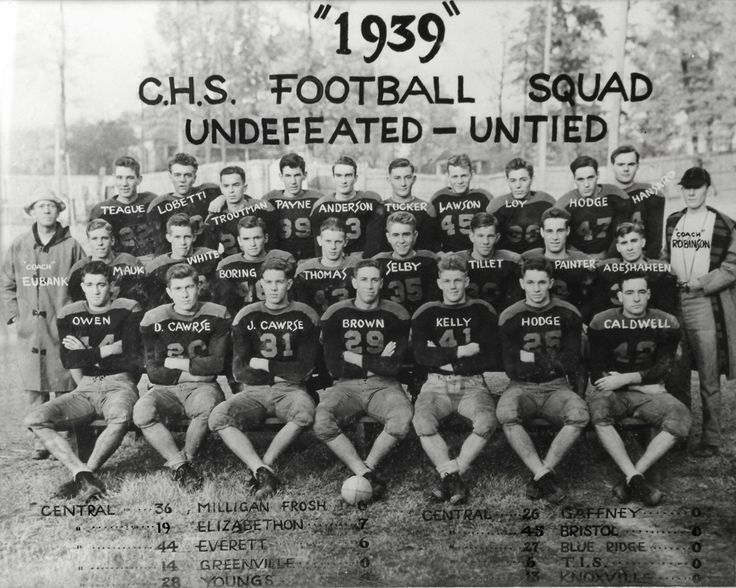Coaches like Dan Boring, Frank “Boomer” Boring, Thomas Schumpert, Joel Helton, O.C. Lloyd, “Bud” Bales, Bryson Rosser and many others were a character-building influence at Central High School. However, it was the coaching team of Harvey L. Robinson and Nathan B. “Red” Eubank who helped prepare many for the stresses they would face in World War II. Coaches Robinson and Eubank made a big difference in many young lives. Our community and our country benefited greatly because of them.
Harvey Leigh Robinson was born on March 23, 1908, in Jupiter, N. C. (near Asheville), the son of William D. and Ida Lee (Harris) Robinson. He attended grade school and high school in Weaverville, N.C.

Harvey L. Robinson (1908-1979). Head football coach at Central High School from 1935 to 1941, Robinson later succeeded Gen. Robert Neyland as head coach at the University of Tennessee.
Although he did not play high school football, he won a halfback spot on the Weaverville Junior College team in 1927. By 1928, he was captain of the team and an all-state performer, weighing only 140 pounds. His teams won the North Carolina Junior College championship both years and Robinson scored 150 points or more each season. He then followed his older brother, George, to the University of North Carolina. Chuck Collins, the Notre Dame-trained coach, recast him as a guard. Harvey resigned three weeks later and enrolled at the University of Tennessee.
In the Neyland system, Robinson was assigned to play halfback, but he did not play a lot inasmuch as two all-American halfbacks, Gene McEver and Beattie Feathers, were there at the time. When he looked back years later at his college years at UT, he felt the opportunity to learn fundamental football under Coach Robert R. Neyland was the major benefit of his college career.
The highlight of his years at UT came during the famous battle in the rain with Alabama on Oct. 15, 1932. In the last quarter the Crimson Tide was leading 3-0 when Feathers kicked a soggy ball 70 yards to the Alabama 13. Alabama’s John Cain punted 46 yards on the first down and Robinson ran the kick back 15 yards to the Tide 45. On the muddy field, three plays gained five yards then Feathers punted the ball dead on the Alabama 1-yard line. Van Rayburn blocked Cain’s punt and Feathers scored the only touchdown of the game on third down. The Volunteers won 7-3. Robinson’s timely run had changed field position in Tennessee’s favor at a crucial point in the game and the Vols finished the season on December 3 with a 32-13 win over Florida and a 9-0-1 record.
Years later, when Harry “Hobo” Thayer was asked if he recalled Robinson’s days as a player, he candidly replied, “Sure, everybody remembered Robinson. You know the gang we had. Dodd was a clown. McEver never took anything seriously. Buddy Hackman was in a fog half the time. Robinson was the quiet one. He was always listening when the coaches talked. Good passer too. No horseplay for Robinson. I think he’d already made up his mind to become a coach.”
Upon graduation, Robinson entered an advanced degree program at the University of Michigan, earning a master’s degree in 1933. He then coached at Ducktown for two years (1933-1935) and began a seven-year stint at Knoxville Central High School (1935-1941). Robinson acted as coach of the offense, and Nathan B. “Red” Eubank coached the defense. They formed a coaching combination responsible for a fantastic 56-5-5 record, winning six state titles and one Southern championship. A Robinson-Eubank coached team never lost to arch rival Knoxville High School during those years, although the teams did not play in 1937.*
Legendary sportswriter Harold Harris called the undefeated and untied 1939 state champion Bobcats the “best ever” Central High School football team. The team had Dan Boring at blocking back, Chan Caldwell and Ford Owen at ends, Dave Cawrse at tackle, Jim Cawrse at guard, John Brown at center, Howard Painter at fullback, R.E. Selby at tailback and Mack Hansard in reserve. Hal Kelly and Jim Tillett made the “all-state” team that year. The team captain was tackle John Francis.
In 1941, Coach Robinson left for four years of service (1941-1945) in the Army Physical Reconditioning Program in Long Island, N.Y. When he returned after the war, he became freshman coach at the University of Tennessee and, in 1948, became offensive chief. Insiders considered Coach Robinson the master technician of the single-wing, although he coached the T-formation late in his career. With Robinson as coordinator, using his hyped-up single wing offense that featured a buck lateral series, the Volunteer teams of 1950 and 1951 amassed school records in total offense that stood for several years. They also won the national championship in 1951.
When General Neyland resigned because of his health in 1953, only one season after he had led the Vols to a national championship, Robinson was chosen to succeed him. His 1953 team had a 6-4-1 record, but slid to 4-6-0 a year later. Robinson had inherited a young team and, additionally, an NCAA committee (under Neyland’s leadership) had voted to return to the one-platoon system after four years of two-platoon football. Teaching young players to play both offense and defense, most of whom had never played both ways previously, was quite a challenge.
Neyland, now the athletic director, replaced Robinson with a former Vol All-American end, Bowden Wyatt, who had just won a Southwest Conference title at Arkansas. Typically, Robinson was steadfast in that he never spoke bitterly of the two-year experience. He was always proud that he left the team with a wealth of young talent that he and his staff had recruited and developed. Only two years after his departure, the 1956 team, led by tailback Johnny Majors, went 10-0-0 and captured the Southeastern Conference championship.

Jim Tumblin, retired optometrist and active historian, writes a monthly series on Fountain City for KnoxTNToday.com.


